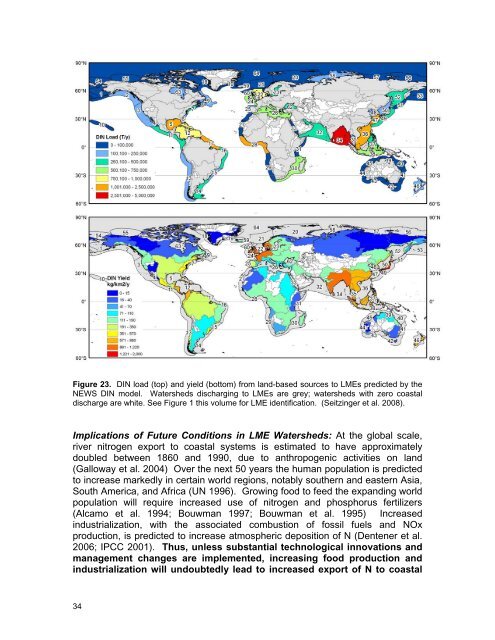Sustaining the World's Large Marine Ecosystems
Sustaining the World's Large Marine Ecosystems
Sustaining the World's Large Marine Ecosystems
You also want an ePaper? Increase the reach of your titles
YUMPU automatically turns print PDFs into web optimized ePapers that Google loves.
Figure 23. DIN load (top) and yield (bottom) from land-based sources to LMEs predicted by <strong>the</strong><br />
NEWS DIN model. Watersheds discharging to LMEs are grey; watersheds with zero coastal<br />
discharge are white. See Figure 1 this volume for LME identification. (Seitzinger et al. 2008).<br />
Implications of Future Conditions in LME Watersheds: At <strong>the</strong> global scale,<br />
river nitrogen export to coastal systems is estimated to have approximately<br />
doubled between 1860 and 1990, due to anthropogenic activities on land<br />
(Galloway et al. 2004) Over <strong>the</strong> next 50 years <strong>the</strong> human population is predicted<br />
to increase markedly in certain world regions, notably sou<strong>the</strong>rn and eastern Asia,<br />
South America, and Africa (UN 1996). Growing food to feed <strong>the</strong> expanding world<br />
population will require increased use of nitrogen and phosphorus fertilizers<br />
(Alcamo et al. 1994; Bouwman 1997; Bouwman et al. 1995) Increased<br />
industrialization, with <strong>the</strong> associated combustion of fossil fuels and NOx<br />
production, is predicted to increase atmospheric deposition of N (Dentener et al.<br />
2006; IPCC 2001). Thus, unless substantial technological innovations and<br />
management changes are implemented, increasing food production and<br />
industrialization will undoubtedly lead to increased export of N to coastal<br />
34









